New Ukrainian jet UAV
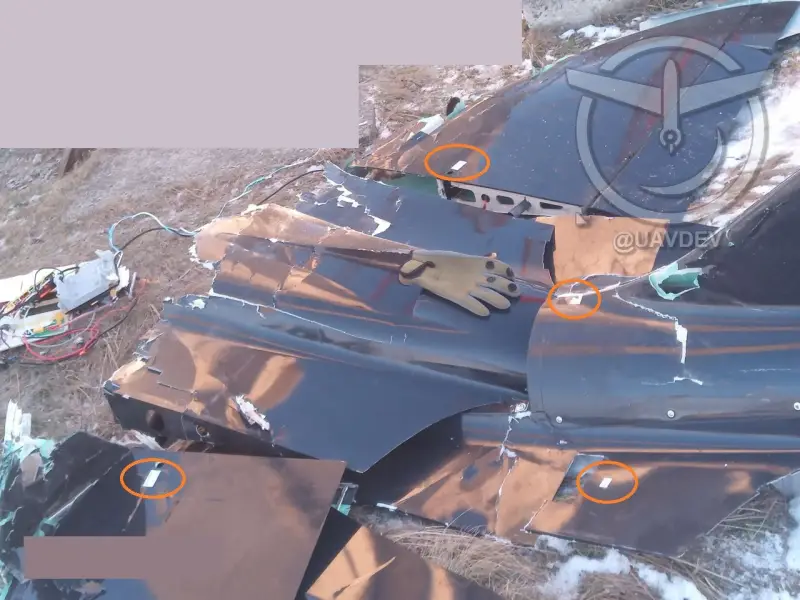
Wreckage of a previously unknown UAV. The center section, consoles and tail boom are visible. Labels on parts are marked in orange.
The Kiev regime regularly attempts terrorist attacks on Russian territory using unmanned aerial vehicles. For this purpose, UAVs of various models are used, and new ones appear regularly. The other day it became known that Ukrainian forces had a new kamikaze drone with a jet engine at their disposal. Its characteristic technical appearance suggests foreign origin.
Target for air defense
The Russian Ministry of Defense regularly reports on the suppression of Ukrainian attacks using UAVs by the air defense forces on duty. Air defense systems and crews promptly detect unmanned aerial targets flying from the direction of Ukraine and suppress or shoot them down. The enemy uses different types of equipment, but modern Russian radars and air defense systems in the vast majority of cases successfully cope with them.
On February 7, photographs of the wreckage of a previously unknown UAV appeared on specialized resources and blogs. It is believed that this product was launched in Ukraine and was heading to a target on Russian territory. However, the flight mission was not completed and the drone crashed in an unknown area. How exactly he was suppressed or struck is unknown. The condition of the objects in the published photographs does not allow us to draw accurate conclusions.
The found debris, like the UAV itself, has several interesting features. The device was built using modern technologies and materials, and is also distinguished by a high production culture. In addition, the product is equipped with a small-sized German-assembled turbojet engine. Along with other fragments of the structure, a warhead similar to already known products in service with the Kyiv regime was discovered.
Reliable information about the origin of such a UAV, its name, characteristics, etc. remain unknown for now. However, various features of the debris allow us to make preliminary assumptions and conclusions. Even its poor condition does not interfere with understanding the general features of the product - when it fell, the device actually fell into pieces and lost some parts.
It is curious that the Ukrainian side has not yet boasted of its new jet UAV and has not declared its appearance as another “overcome.” Perhaps this is due to the failure of an attempt to use it in combat. A downed or suppressed drone would hardly be shown in a good light.
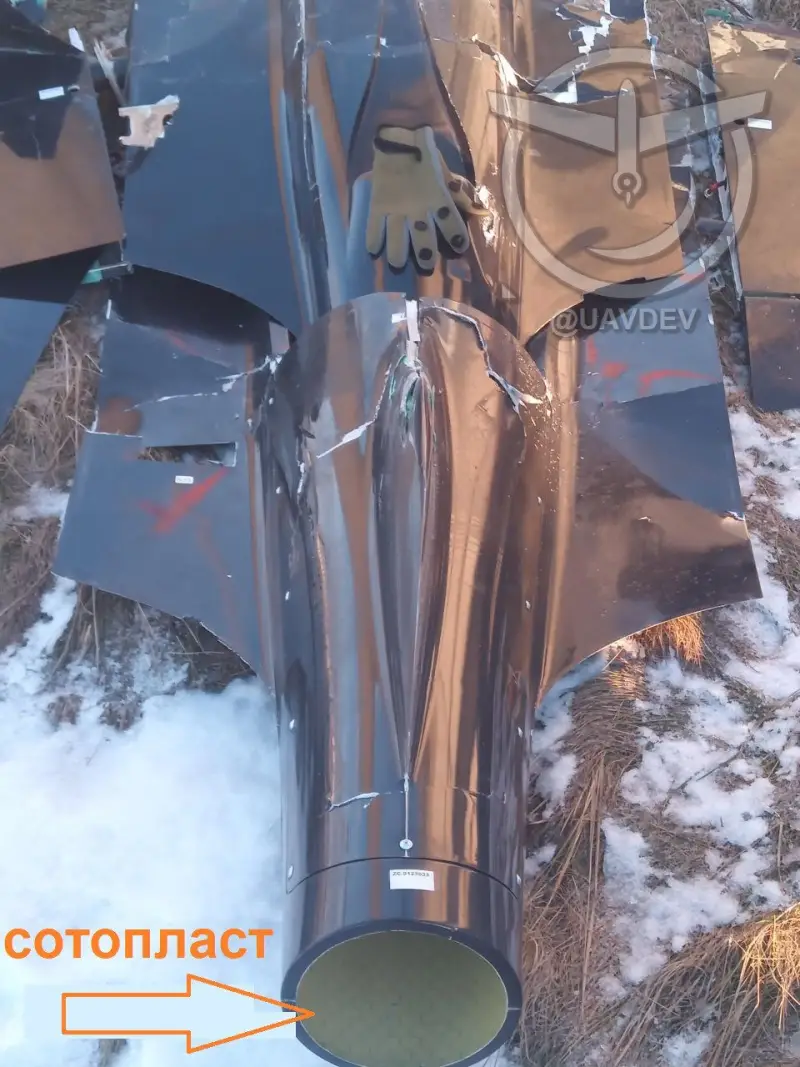
View from the tail
New design
The new Ukrainian UAV is built according to the “tailless” design with a delta wing. Judging by the wreckage, it has a cylindrical fuselage of high aspect ratio; the nose protrudes significantly in front of the wing. A mid-mounted wing with simple mechanization on the trailing edge was used. A keel is also provided. The warhead and control systems are located in the forward part of the fuselage. The center probably houses the fuel tank, while the tail is used for the engine. The air intake is located under the bottom.
The design of the airframe and the materials used in it are of interest. It seems that the airframe is assembled from large units made of fiberglass. Composite parts are complemented by a power set made of carbon fiber and plywood. Honeycomb plastic was seen in the tail where the engine is located. A UAV with such a glider must be highly lightweight and have good aerodynamics, which will improve flight performance.
The drone is equipped with a small-sized P400-Pro turbojet engine manufactured by the German company JetCat. This product has a length of 390 mm and an outer diameter of approx. 150 mm. Weight – approx. 4 kg. During operation, it develops a temperature in front of the turbine of up to 750°C and creates a thrust of 425 N. At maximum thrust, fuel consumption reaches 1,4 l/min. The control system is electronic, adapted for use on remotely controlled aircraft.
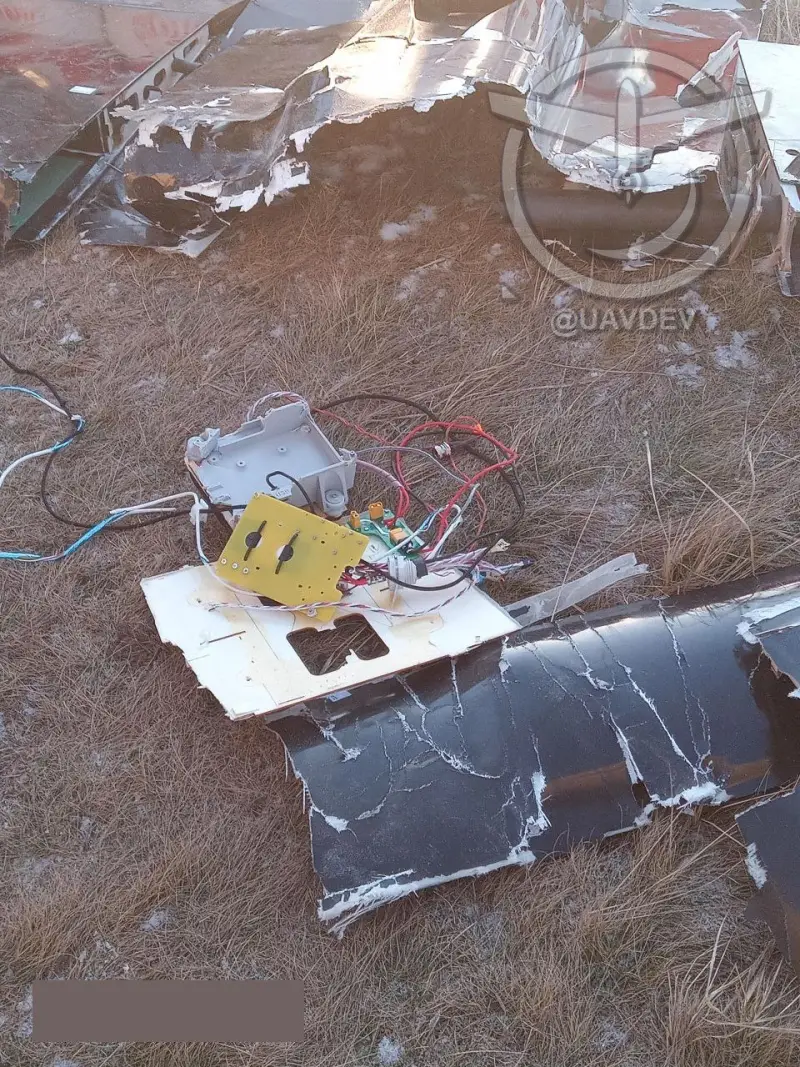
UAV electronic components
A turbojet engine allows you to obtain a high thrust-to-weight ratio and accelerate the UAV to fairly high speeds. However, the drone appears to be subsonic. Flight range is unknown. At the same time, the available data allows us to assume the ability to fly hundreds of kilometers, depending on speed, range and other factors.
The UAV received a high-explosive fragmentation warhead. This product is probably designated PKK-10. The warhead is made in a cylindrical body, almost completely filled with explosive. In the bow of the hull, ready-made striking elements in the form of balls are placed or a cumulative funnel is made. Warhead weight – up to 20 kg.
Detailed information about control systems is not yet available. Judging by the photographs shown, the UAV only has navigation aids and an autopilot, allowing it to fly along a given trajectory. There are no surveillance or detection systems, optical or radio engineering. All this indicates the ability of the drone to fly only along a given route to a pre-designated target with constant coordinates.
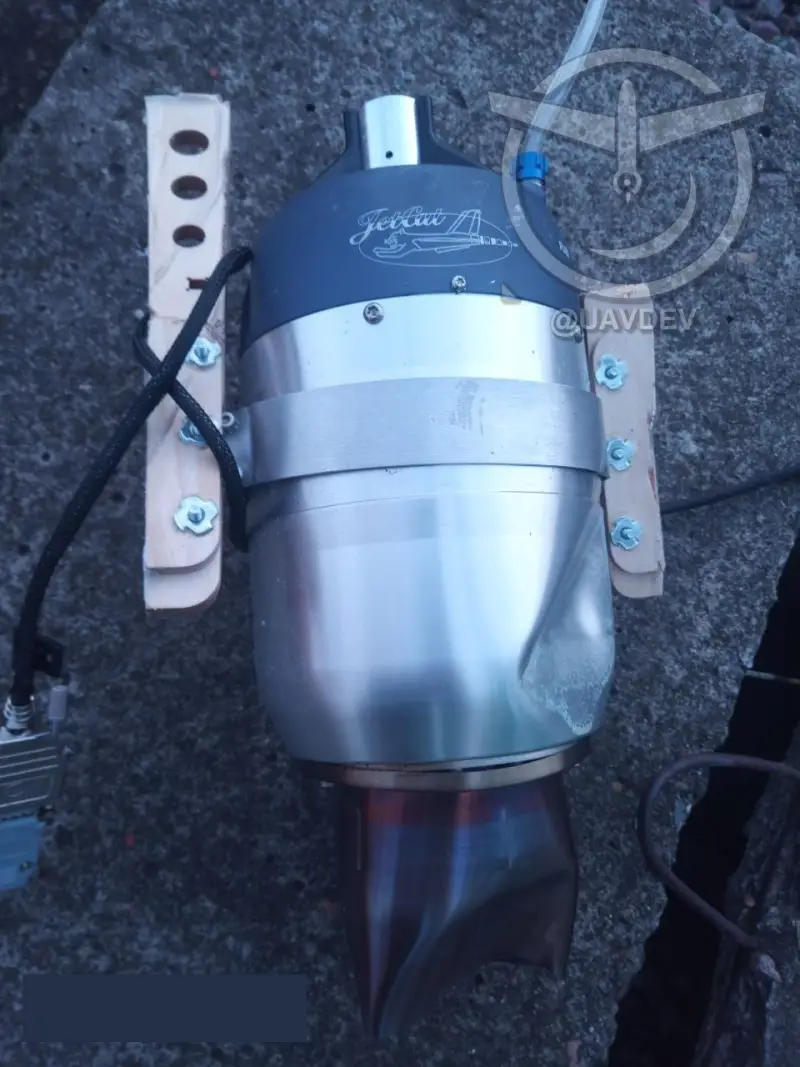
JetCat P400-Pro Engine
Foreign footprint
The new jet UAV is used by the armed forces of the Kyiv regime, but it is unlikely that it was developed independently. The foreign origin of the device is indicated by some design features, its components and markings. The drone was likely designed abroad, and at least some of the construction is taking place there.
The airframe of the device is made of fiberglass. In addition, it is made carefully - much better than parts for other Ukrainian UAVs. This indicates production in a factory environment, and in a fairly developed enterprise. The device also has an imported engine and electronics based on foreign components. All this makes one suspect the presence of a foreign trace.
All the main elements of the airframe and the engine received tags with markings, probably with the serial number of the aircraft. The same markings are present on some other Ukrainian UAVs. The authors of the telegram channel “UAV Developer” believe that such designations are further evidence of the foreign origin of the aircraft. According to them, the drone parts are manufactured in the USA and then delivered to Ukraine. The final assembly is carried out at Ukrainian facilities, and tags with a number allow you to identify the details of a particular product and prevent errors.
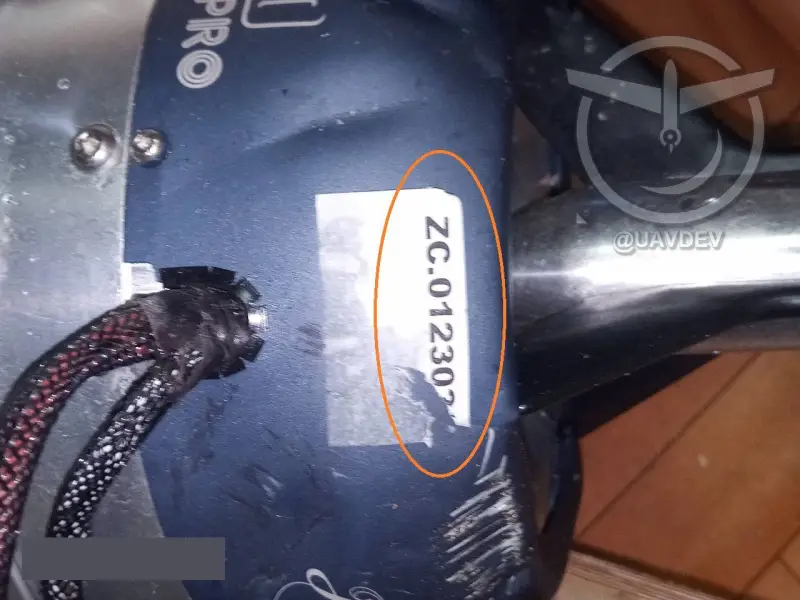
Marking on the engine. Similar labels are available on other parts.
Experience
It is now known that the enemy has another strike UAV at its disposal, capable of threatening troops in the combat zone and civilian targets in the rear. It is distinguished by high quality manufacturing and should show good flight and combat characteristics. It should be expected that the Kiev regime will continue to use such technology when available.
The interest of the Kyiv regime in such technology is quite understandable. He wants to continue terrorist attacks on targets deep inside Russian territory, but is having great difficulty weapons and the technology for this. The missile and artillery forces, as well as the air force, can no longer cope with all tasks without risk, and an alternative solution is needed. They are any long-range attack UAVs, preferably as simple and cheap as possible.
It is assumed that the new jet UAV was created with the active assistance of foreign countries, probably the USA or Great Britain. They too can benefit from such cooperation. First of all, these countries solve their military-political problems and indirectly continue to harm Russia. In addition, with the help of Ukrainian formations, NATO countries are testing new developments in real combat conditions. Probably, the Pentagon wants to gain experience in the development and operation of UAVs of various designs and use it later in its own interests.
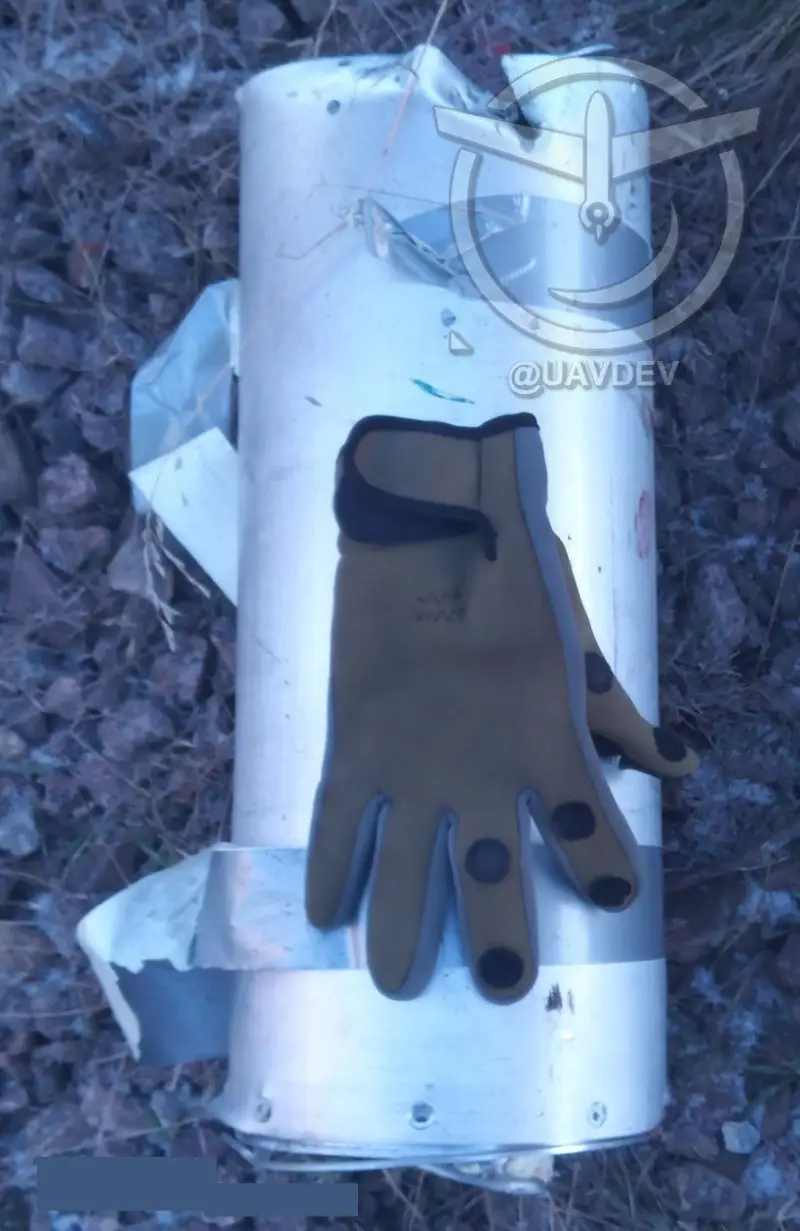
High-explosive fragmentation warhead
At the same time, the Russian air defense is also learning. The enemy is trying to attack our targets and is actually creating a target environment. Crews of radars and anti-aircraft systems have the opportunity to test and improve their skills and abilities. At the same time, they have a special responsibility - unlike training at the training ground, such aerial targets cannot be missed.
Another threat
Thus, the Kiev regime, independently or through assistance from abroad, is bringing new models of unmanned aerial vehicles to operation and combat use. aviation technology. This time they tried to use a long-range kamikaze drone of a special design and specific appearance. Fortunately, the attempt was unsuccessful, and the damaged UAV crashed somewhere in the area.
The position of the Kyiv regime is constantly deteriorating, and the potential of its armed forces is declining. Due to the negative situation at the front, he will try to look for alternative methods of struggle. In particular, we should expect new terrorist attacks using long-range strike UAVs. At the same time, Ukrainian formations can still count on help from abroad, but the volume and pace of supplies are already in question.
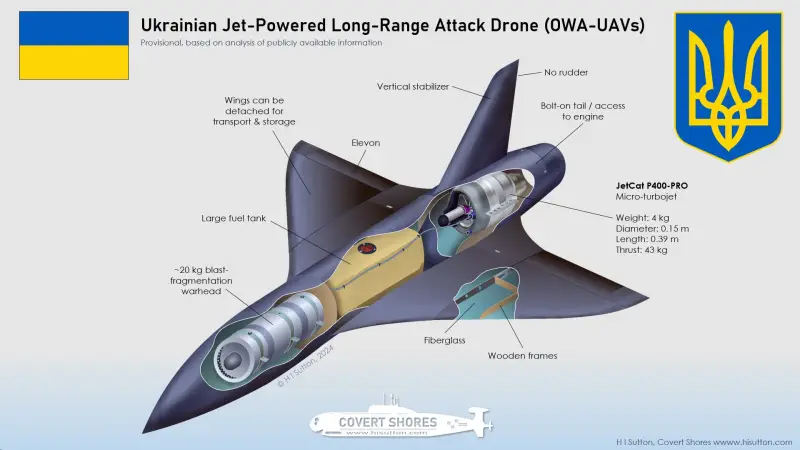
Information